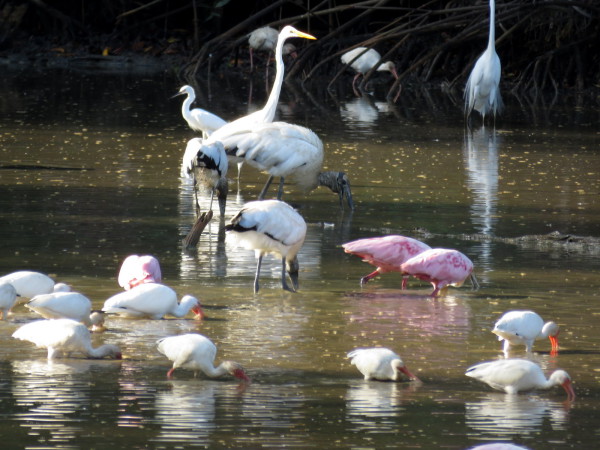In Costa Rica there are some habitats that can only be explored by boat – the mangrove estuaries, the water trails and canals of Tortuguero National Park and the flooded wetlands of Caño Negro Wildlife Refuge.

No experience is necessary and paddling is surprisingly easy even the first time. Sit on top kayaks are amazingly stable and the feeling of gliding silently under trees full of chattering monkeys, sleeping sloths and perching birds is unforgettable.
Guides are highly recommended mostly because they enhance the experience by pointing out wildlife novice eyes would likely miss. A naturalist guide will also explain the fascinating lives of the plants and animals that you encounter. Many of the waterways wind and twist back on themselves creating confusing mazes and you may also appreciate your guide’s sense of direction when it’s time to head back for lunch.
Most birds and animals are less concerned with or intimidated by people when they don’t look like people. It’s much easier to approach closely without startling or disturbing them when you’re in a boat. The same applies to a car or SUV so if you spot something alongside the road you may want to try to get a photo out the window before getting out to take a better look.
Fresh Water Wetlands, Lagoons, Canals and Water Trails
The two most popular locations in Costa Rica to paddle on fresh water are the senderos acuaticos at Tortuguero and the Río Frío and Wetlands of Caño Negro.
There are a number of places you can rent canoes (and a few kayaks) in Tortuguero village and some of the eco-lodges provide them free of charge to guests. All of the inland waterways around Tortuguero are glassy smooth and other than a gentle current in the main river, totally calm.
You can spend a few hours on the lagoon across from the village or stop in at the park office on the south end of town and pay your entrance fee to the national park and explore the unique senderos acuaticos (water trails). The channels of the water trails are too small for the motorized tour boats so you’ll have a quiet experience. The trails are signed like hiking trails and all dead end without confusing branches so you can confidently navigate in, turn around and head back out to where you entered.
In Caño Negro there can be significant currents in the Río Frío where most of the motorized tour boats cruise. The motor tours almost all start from the dock at Los Chiles but if you want to kayak you should head south and west from there on the gravel road to the village of Caño Negro where you’ll find calmer water and the official entrance to the Wildlife Refuge. A guide is recommended for beginners.
As mentioned above both locations do offer motorized wildlife safaris in canopied launches if you’re not feeling up to paddling but we highly recommend quiet solo gliding.
Mangrove Estuaries
There are three popular motorized tours of the mangroves in Costa Rica at the Damas Estuary, Terraba Sierpe and the Río Tempisque and you can also rent kayaks and find guides for paddling tours at each of these.

However there are many less visited places to experience this incredible ecosystem. Most Costa Rican rivers end in a mangrove estuary where they meet the ocean. Some of the best tours we’ve done (Hatillo near Dominical on the central Pacific and Javillos between Playas Coyote and San Miguel on the Nicoya Peninsula) have been on these smaller mangrove swamps.

The mangrove trees are uniquely adapted to this environment where fresh and salt water mix and protect habitat for sloth, raccoon, mangrove crabs that feed in the trees and mate in the water and hundreds of wading and fishing birds. It’s a safe easy and remarkably rewarding experience to paddle quietly under the shade of the mangroves – just don’t forget the mosquito repellent because at times they are oddly absent but sometimes they are fierce.

There are mangrove tours on nearly every stretch of Coast Rica’s coastline.
Sea Kayaking

Sea kayaking requires a bit more finesse and may take a couple of lessons before you’re comfortable enough to head out through the breakers to the open ocean where the swells gently lift you.

